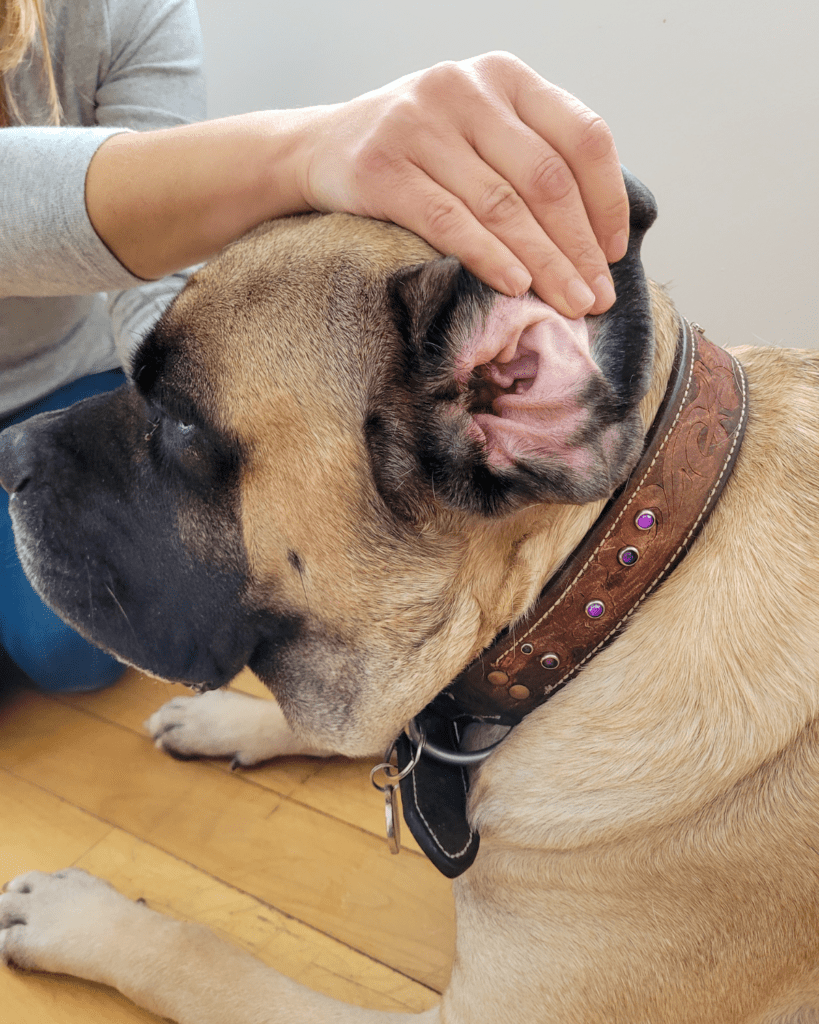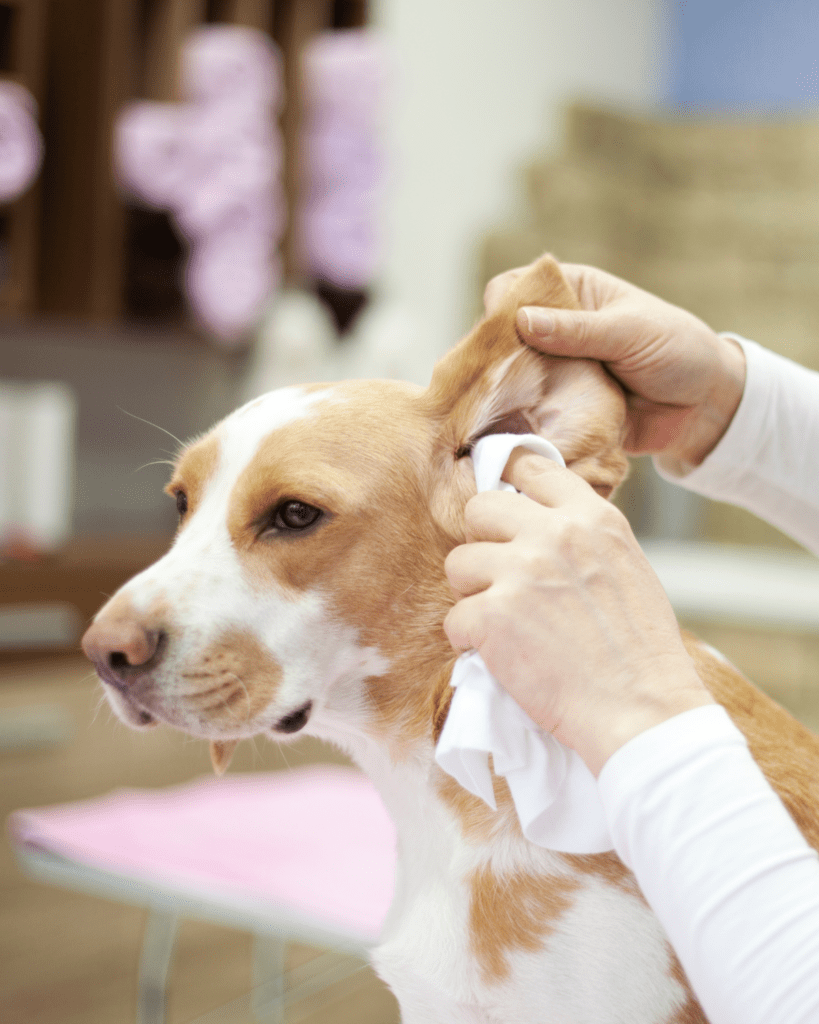About Dog Ear Yeast Infections: Causes, Symptoms & Treatment
By admin / May 8, 2023 / No Comments / Uncategorized
Yeast infections in the ear are so uncomfortable for our dogs. It’s something that makes my dogs really pathetic.
As a dog owner, it’s important to be aware of the various health issues that can affect your furry friend. One of the most common problems that dogs face are ear infections, and yeast-based ear infections are particularly common.
Yeast infections can be uncomfortable and painful for your dog, and if left untreated, they can lead to more serious health problems. In this blog post, we’ll take a closer look at yeast-based ear infections in dogs, exploring the causes, symptoms, and treatment options available to help your furry friend stay happy and healthy.
Note: This article has been prepared for informational purposes, and is not a tool for you to diagnose! This is veterinary territory as a yeast overgrowth is one thing, but we always want to make sure to treat underlying conditions to ensure the continued overall health of our dogs.
What Causes Yeasty Ear Infections?
Yeast infections in dog ears can be caused by trapped water or debris in the ear canal, allergens such as pollens, mold, dust, feathers, cigarette smoke, and cleaning products, a weakened immune system, bacterial infections, ear mites, or an unbalanced diet rich in carbohydrates like grains, legumes, and starches.

Why Are Yeast Infections So Painful For Dogs?
Yeast infections in the ear can be painful for dogs due to the irritation and inflammation that the infection causes. Dogs with yeast infections may shake their head, scratch their ears or paw at the ears, and may be reluctant to have their head and ears touched due to discomfort. In addition, a dog with a yeast infection can develop painful ears.
What Are The Symptoms Of A Yeast Ear Infection In Dogs?
The symptoms of a yeast ear infection in dogs include:
- Scratching at the ears
- Head shaking or tilting
- Redness or swelling inside the ear
- Painful ears (e.g. yelping to the touch)
- Yeasty odor from the ears
- Excessive ear wax or debris
- Thickened ear flaps
- Ear skin scaling
- Drooping ears
In addition, there may be a buildup of yellow, brown, or black waxy discharge in the ears that’s pretty stinky.
It is important to note that these symptoms are not unique to yeast ear infections and can also be caused by other conditions. If you suspect your dog has a yeast ear infection, it is recommended to bring them to the vet for a proper diagnosis and treatment plan.

Why Does Yeast Grow In Dog Ears?
Yeast grows in a dog’s ear infection due to the structure of a dog’s ear canal. A dog’s ear canal plunges downward and then towards the head, creating a favorable environment for yeast to grow.
Additionally, if water enters the ear canal during a bath and the ears do not properly dry out, yeast can reproduce and cause an infection.
Yeast infection in dog’s ears is a specific ear infection that develops when yeast species (Malassezia pachydermatis) that normally populate the dog’s ears overgrow. The overgrowth of yeasts leads to a disrupted balance of microorganisms in the ears, resulting in an ear infection.
Are Some Dogs More Prone To Yeast Based Ear Infections?
while any dog can develop an ear infection, some breeds and types are more prone than others. Different breeds are prone to ear infections for various reasons. For instance, breeds that have more hair growing in their ear canals are more likely to get ear infections, such as Schnauzers and Poodles. Dogs that are swimmers are also prone to ear infections, such as the Labrador Retriever, Golden Retriever, Chesapeake Bay Retriever, and Portuguese Water Dog. Additionally, breeds with genetic predispositions for infection-prone ear canals are more prone to ear infections, such as:
- Bassett Hounds
- Cocker Spaniels
- Coonhounds
- Labrador Retrievers
- Golden Retrievers
- Irish Setters
- Irish Water Spaniels
- Newfoundland
- Bullmastiffs
- Doodles
Generally speaking, floppy eared dogs are much more prone to yeast based ear infections than pointy eared dogs. Whilst floppy ears are adorable, they absolutely are more prone to dog ear infections.

How can I prevent yeast based ear infections in my dog?
Prevention is better than cure. Always. I say that a lot, huh? But it’s so true.
1 – Regularly clean your dog’s ears. Regular ear cleaning is crucial to prevent yeast-based ear infections in dogs. Use a gentle, vet-approved ear cleaning solution and a cotton ball or soft towel to clean the outer part of the ear. You can ask your vet for their recommended ear cleaners.
2 – Keep your dog’s ears dry. Moisture in the ears can create a breeding ground for yeast. After bathing or swimming, gently dry the outer part of the ears to ensure that you’re not creating a damp, warm environment, as these sorts of moist environment is what yeast loves.
3 – Trim excess hair around the ear canal. Excess hair can trap moisture in the ears and prevent proper air circulation, increasing the risk of infections. You should absolutely discuss this with your groomer if your dog is getting repeat ear infections.
4 – Feed your dog a healthy diet. Diet & food allergies can contribute to your dog’s yeast infections. Food containing carbohydrates like grains, legumes, and starches can trigger food sensitivities that upset your dog’s microbiome. When the gut flora is unbalanced, your dog’s good bacteria is overrun by pathogenic bacteria that encourage the yeast to grow. It is recommended to avoid feeding your dog a high-carbohydrate diet and instead opt for a low-carbohydrate, high-protein diet to help prevent yeast infections.
5 – Seek veterinary care for any signs of infection. If you notice any of the symptoms of a yeast ear infection, such as excessive scratching, head shaking, or a yeasty odor from the ears, seek veterinary care immediately. Early detection and treatment can prevent the infection from becoming more serious.
By following these steps, you can help keep your dog’s ears healthy and prevent yeast-based ear infections.
6 – Keep Your Dog Healthy. Inner ear infections (the same as all infections) are going to be more prevalent in dogs with weaker or weakened immune systems. So happy, healthy, rested and that way the yeast levels in your dog will stay in balance!
7 – Be Aware of hot humid weather. The weather absolutely does affect your dog’s body, and your dogs’ ears are no different. Try and keep your dog’s ears extra extra clean during the summer months.
How Do I Clean My Dog’s Ears?
Cleaning dog ears is really not often the most favourite thing in the world for most dogs. This is a variant on a veterinary procedure to add in comfortable training. However, you can make it a stress-free process by desensitising it and using a lot of rewards. As a note; Q-tips or other cotton buds should not be avoided particularly in small or narrow ears as when we are cleaning a dogs ears, we really want to make sure not to push any foreign objects further into the ear canal.
Note: You may choose to prepare a lickimat to distract your dog during this process and make it very rewarding throughout.
- Assemble real (not synthetic) cotton balls and the ear cleaning solution. It is best to use saline solution (such as those used for eye rinsing) to clean the ear or something prescribed by your vet. Avoid over-the-counter ear cleaners.
- Squirt enough cleaner into the ear to fill the canal.
- Massage the base of the ear until you hear the solution “squish”. Praise your dog gently and calmly
- Gently hold the base of the ear and pull the ear flap up and away from the head in order to straighten out the “L” shape of the canal.
- Wad the cotton into a tubular shape and gently insert it into the canal as far as it will comfortably go.
- Again, gently massage the base of the ear to help work debris and cleaning solution toward the cotton and dry the canal.
- Remove the cotton ball.
- Wait a few minutes before using any medication in the affected ear as instructed by your veterinarian.
- You can clean the ear flap with a soft cotton cloth or wash cloth using the same solution.
- Reward throughout.
If you haven’t desensitized this process and this is sore, please do muzzle your dog just in case.

Can I Treat My Dog’s Yeast Ear Infection Naturally?
Yes, you can treat your dog’s ear yeast infection naturally. There are several home remedies that can be used to manage a yeast infection in a dog’s ears, which include coconut oil, apple cider vinegar, essential oils*, and white vinegar.
These remedies can be used to clean the outer part of the ear flap and canal by dabbing a cotton ball in them. However, if the symptoms persist or worsen, it is important to consult a veterinarian and seek medical advice.
* Please be careful using essential oils with dogs as some can be toxic!!
How Do Vets Treat Yeast Ear Infections In Dogs?
The treatment of a yeast ear infection in dogs involves the use of topical antifungal medications such as miconazole and clotrimazole, which are administered directly into the ear canal.
For more severe infections, oral antifungal medication may also be prescribed. Some medications may also contain anti-inflammatory drugs to reduce inflammation and discomfort. Additionally, the veterinarian will thoroughly clean the dog’s ears using a medicated ear cleanser.
It’s important to note that treatment may vary depending on the severity of the infection, so it’s best to consult with a veterinarian to determine the most appropriate course of treatment for your dog.
Is It Possible These Symptoms Aren’t A Yeast Infection?
Actually, yes.
Ear mites presents very similarly.
Ear mites are tiny, microscopic bugs or parasites that live inside and around the ear canals of dogs, feeding on ear wax, oils, cellular debris, and lymph fluid from under the skin. The mites live and burrow in the outer or external part of the ear canal causing irritation, inflammation, and intense itching. The first sign of an ear mite infestation may be your dog scratching his head. Other symptoms include dark, crumbly reddish-brown discharge, which is often composed of dried blood and will resemble coffee.
Ear mites in dogs are highly contagious parasites that live on skin surface and in ear canals. The dog ear mite belongs to the Psoroptidae family, which is a group of parasitic mites that live on the surface of the skin rather than burrowing into it, as some families of mites do. Ear mites are highly contagious, and animals become infested by direct contact with another infested animal [4]. If you suspect your dog has ear mites, it’s important to take them to the veterinarian to get proper diagnosis and treatment.
Allergic Reaction may also look similarly, so it is a fantastic idea to get an accurate diagnosis of your pet. Allergy testing for environmental allergies is also important to discuss on your dog’s appointment to make sure we find the underlying cause of your pup and their pain.
Yeast Infections Are The Most Common Type Of Ear Infection
the overgrowth of yeast affects skin folds as much as it does the middle ear. Your dog’s ear canal is just really prone to this type of yeast, and we always want to ensure effective treatments of the infected area. And do talk to your vet, as permanent damage to the ears is no joke, but with good cleaning and regular maintenance you should help your dog to keep the correct balance of yeast.
Remember that training is the foundation of cooperative care! If you need help establishing a cooperative care routine, get in touch.
Author, Ali Smith
Ali Smith is the Positive Puppy Expert, dog trainer and is the founder of Rebarkable. She is passionate about helping puppy parents get things right, right from the start. To help create a puppy capable of being a confident and adaptable family member and keep puppies out of shelters.
Ali has won multiple awards for her dog training, and has had her blog (this blog!) rated as 2021 & 2022 worlds’ best pet blog!
